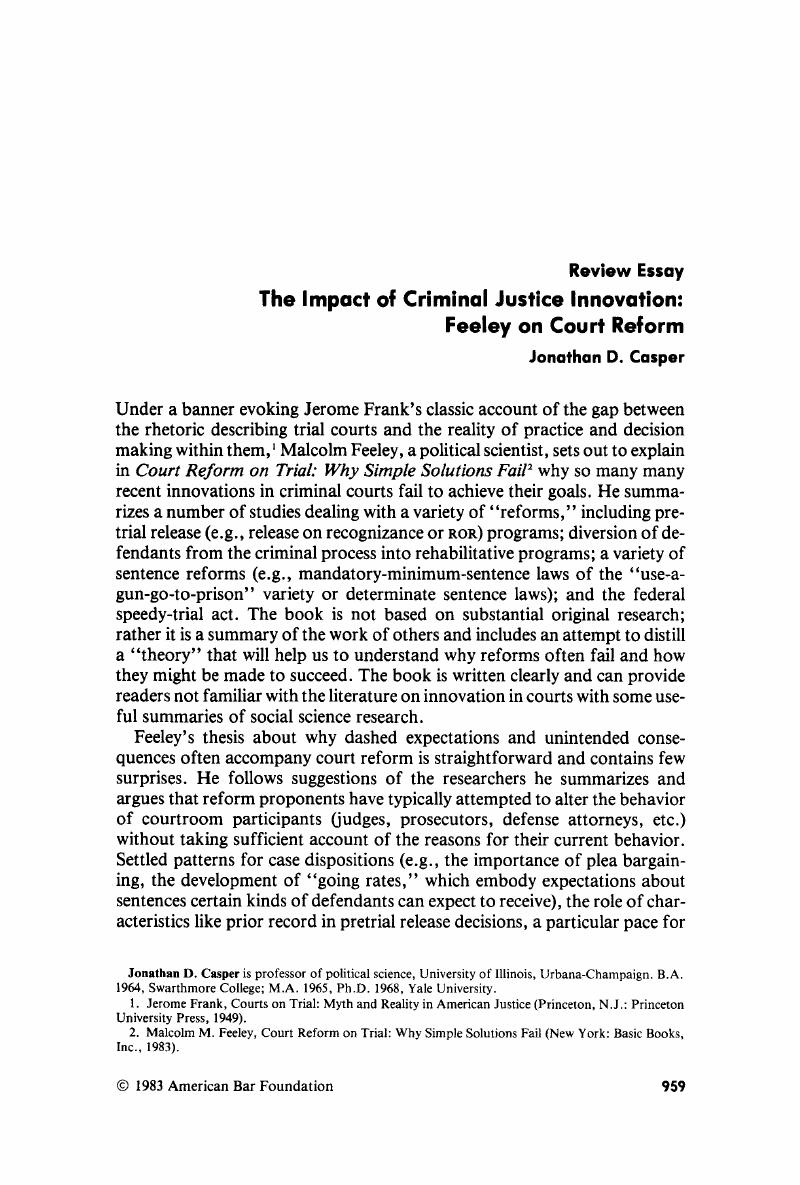No CrossRef data available.
Published online by Cambridge University Press: 20 November 2018

1 Jerome Frank, Courts on Trial: Myth and Reality in American Justice (Princeton, N.J.: Princeton University Press, 1949).Google Scholar
2 Malcolm M. Feeley, Court Reform on Trial: Why Simple Solutions Fail (New York: Basic Books, Inc., 1983).Google Scholar
3 Milton Heumann, Plea Bargaining: The Experiences of Prosecutors, Judges, and Defense Attorneys (Chicago: University of Chicago Press, 1977).Google Scholar
4 . Heumann, Milton & Loftin, Colin, Mandatory Sentencing and the Abolition of Plea Bargaining: The Michigan Felony Firearms Statute, 13 Law & Soc'y Rev. 393 (1979).Google Scholar
5 . Id. For a later study by the same authors, see Colin Loftin, Milton Heumann & McDowall, David, Mandatory Sentencing and Firearms Violence: Evaluating an Alternative to Gun Control, 17 Law & Soc'y Rev. 287 (1983).Google Scholar
6 See Jonathan D. Casper, David Brereton & David Neal, The Implementation of the California Determinate Sentence Law (Washington, D.C.: National Institute of Justice, 1982); Sheldon Messinger, Report on Strategies for Determinate Sentencing, unpublished.Google Scholar
7 Stuart A. Scheingold, The Politics of Rights: Lawyers, Public Policy, and Political Change (New Haven, Conn.: Yale University Press, 1974).Google Scholar
8 . Miranda, V. Arizona, 384 U.S. 436 (1966); Mapp v. Ohio, 367 U.S. 643 (1961).Google Scholar
9 E.g., in the case of the Miranda warnings, police were frequently found to give only partial warnings, to give them in minatory tones that suggested that it was not in the interest of suspects to take advantage of the rights of which they were being informed, or to present them in bureaucratic tones that suggested that a meaningless ritual was in progress, see Michael Wald, Interrogations in New Haven: The Impact of Miranda, 76 Yale L.J. 1519 (1967); Richard J. Medalie, Leonard Zeitz & Paul Alexander, Custodial Police Interogation in Our Nation's Capital: The Attempt to Implement Miranda, 66 Mich. L. Rev. 1347 (1968). The implementation of the exclusionary rule announced in Mapp is also replete with examples of police behavior designed to circumvent its effects. For example, a study of its impact during the six months after its announcement showed a marked increased in so-called “dropsy” cases in New York City courts—that is, cases in which officers testified that contraband seized from suspects had fallen from their pockets and was thus in plain sight. (Comment, Effect of Mapp v. Ohio on Police Search-and-Seizure Practices in Narcotics Cases, 4 Colum. J.L. & Soc. Probs. 87 (1968) For a summary of the impact of the exclusionary rule, see Dallin Oaks, Studying the Exclusionary Rule in Search and Seizure, 37 U. Chi. L. Rev. 665 (1970); Jerome H. Skolnick, Justice Without Trial: Law Enforcement in Democratic Society (New York: John Wiley & Sons, 1966).Google Scholar
10 Edmond Cahn, Confronting Injustice: The Edmond Cahn Reader, ed. Lenore L. Cahn (Boston: Little, Brown, & Co. 1966).Google Scholar
11 Scheingold, supra note 7.Google Scholar